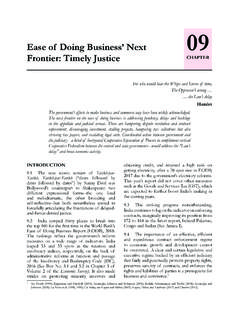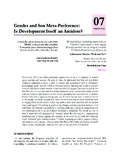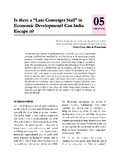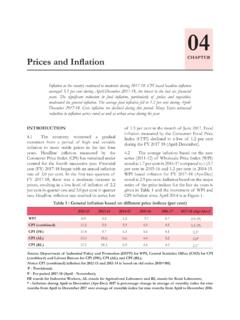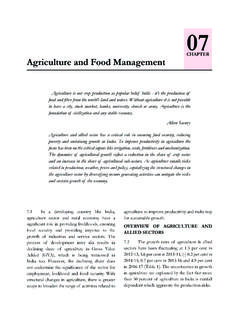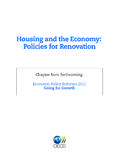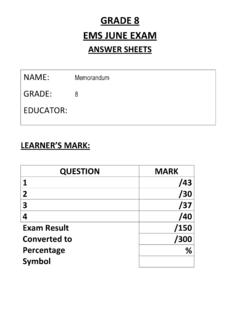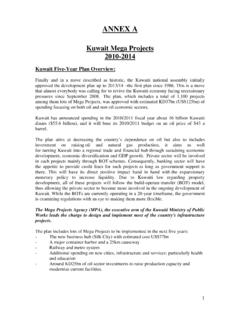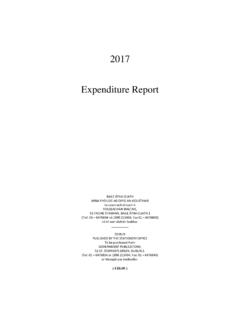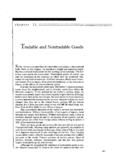Transcription of 01 - mofapp.nic.in:8080
1 State of the economy : An Analytical Overview and Outlook for Policy01 CHAPTEROVERVIEW: SHORT The past year has been marked by some major reforms. The transformational Goods and Services Tax (GST) was launched in July 2017. With a policy change of such scale, scope, and complexity, the transition unsurprisingly encountered challenges of policy, law, and information technology systems, which especially affected the informal sector. Expeditious responses followed to rationalize and reduce rates, and simplify compliance burdens. The inevitable never happens. It s the unexpected alwaysJohn Maynard KeynesMajor reforms were undertaken over the past year.
2 The transformational Goods and Services Tax (GST) was launched at the stroke of midnight on July 1, 2017. And the long-festering Twin Balance Sheet (TBS) problem was decisively addressed by sending the major stressed companies for resolution under the new Indian Bankruptcy Code and implementing a major recapitalization package to strengthen the public sector banks. As a result of these measures, the dissipating effects of earlier policy actions, and the export uplift from the global recovery, the economy began to accelerate in the second half of the year. This should allow real GDP growth to reach 6 percent for the year as a whole, rising to 7-7 percent in 2018-19, thereby re-instating India as the world s fastest growing major economy .
3 Against emerging macroeconomic concerns, policy vigiliance will be necessary in the coming year, especially if high international oil prices persist or elevated stock prices correct sharply, provoking a sudden stall in capital flows. The agenda for the next year consequently remains full: stablizing the GST, completing the TBS actions, privatizing Air India, and staving off threats to macro-economic stability. The TBS actions, noteworthy for cracking the long-standing exit problem, need complementary reforms to shrink unviable banks and allow greater private sector participation.
4 The GST Council offers a model technology of cooperative federalism to apply to many other policy reforms. Over the medium term, three areas of policy focus stand out: Employment: finding good jobs for the young and burgeoning workforce, especially for women. Education: creating an educated and healthy labor force. Agriculture: raising farm productivity while strengthening agricultural resilience. Above all, India must continue improving the climate for rapid economic growth on the strength of the only two truly sustainable engines private investment and exports. At the same time, decisive action was taken to grasp the nettle of the Twin Balance Sheet (TBS) challenge, arguably the festering, binding constraint on Indian growth prospects.
5 On the 4 R s of the TBS recognition, resolution, recapitalization, and reforms recognition was advanced further, while major measures were taken to address two other R s. The new Indian Bankruptcy Code (IBC) has provided a resolution framework that will help corporates clean up their balance sheets and reduce their debts. And in another critical move, the government announced 2 | Economic Survey 2017-18 Volume 1a large recapitalization package (about percent of GDP) to strengthen the balance sheets of the public sector banks (PSBs). As these twin reforms take hold, firms should finally be able to resume spending and banks to lend especially to the critical, but-currently-stressed sectors of infrastructure and manufacturing.
6 Macroeconomic developments this year have been marked by swings. In the first half, India s economy temporarily decoupled, decelerating as the rest of the world accelerated even as it remained the second-best performer amongst major countries, with strong macroeconomic fundamentals. The reason lay in the series of actions and developments that buffeted the economy : demonetization, teething difficulties in the new GST, high and rising real interest rates, an intensifying overhang from the TBS challenge, and sharp falls in certain food prices that impacted agricultural incomes.
7 In the second half of the year, the economy witnessed robust signs of revival. Economic growth improved as the shocks began to fade, corrective actions were taken, and the synchronous global economic recovery boosted exports. Reflecting the cumulative actions to improve the business climate, India jumped 30 spots on the World Bank s Ease of Doing Business rankings, while similar actions to liberalize the foreign direct investment (FDI) regime helped increase flows by 20 percent. And the cumulative policy record combined with brightening medium-term growth prospects received validation (as argued for in Box 1 of last year s Economic Survey, Volume I) in the form of a sovereign ratings upgrade, the first in 14 These solid improvements were tinged with anxieties relating to macro-economic stability.
8 Fiscal deficits, the current account, and inflation were all higher than expected, albeit not threateningly so, reflecting in part higher international oil prices India s historic macroeconomic These dualities of revival and risk have been reflected in the markets, and in market analysis. For example, bond yields rose sharply, leading to an exceptionally marked steepening of the yield curve even as stock prices continued to surge (Figure 1). Evidently, markets expect rapid growth, which would warrant the run-up in stock prices, but are also pricing in some macro-balance concerns. Similarly, even the ratings upgrade carried warnings of potential macro-economic challenges.
9 Figure 1. Two Assets, Two Messages20,00024,00028,00032,00036, Sensex (RHS)Source: Survey calculations, of the economy : An Analytical Overview and Outlook for Policy | 3 Despite major policy reforms and even in the absence of major new actions, the policy agenda remains full. Over the coming year, the government will need to focus on the 4 R s, ensuring that the process of resolving the major indebted cases and recapitalizing the PSBs is carried to a successful conclusion, while initiating reforms of the PSBs that will credibly shrink the unviable ones and signal greater private sector participation in the future.
10 The government will also need to stabilize GST implementation to remove uncertainty for exporters, facilitate easier compliance, and expand the tax base; privatize Air-India; and stave off any nascent threats to macro-economic stability, notably from persistently high oil prices, and sharp, disruptive corrections to elevated asset prices. If these objectives are achieved, the world economy maintains its growth momentum, and oil prices do not persist at current levels, the Indian economy should resume converging towards its medium-term growth potential that previous Economic Surveys have estimated to exceed 8 percent.
